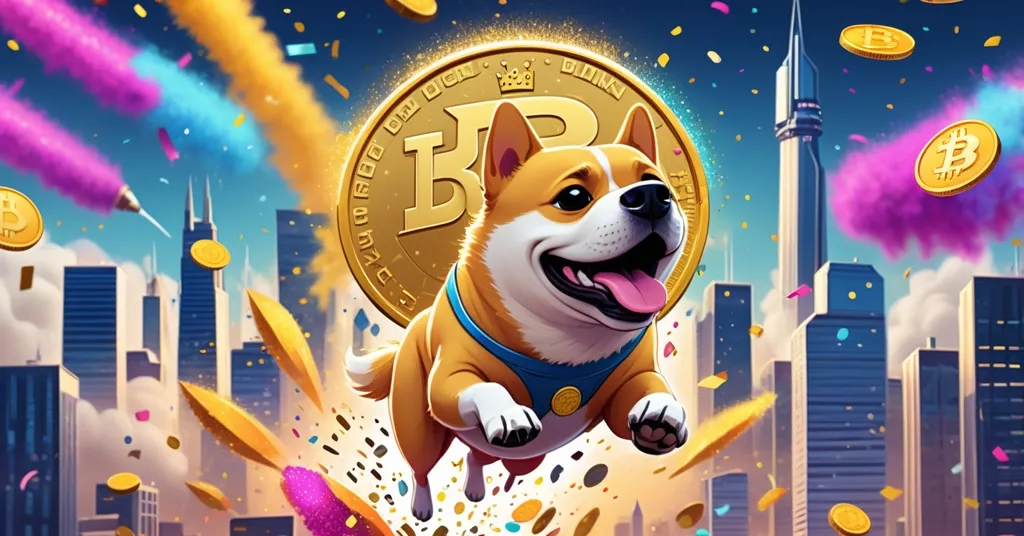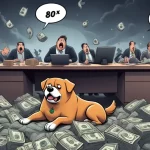BNB Hits $183B Market Cap, Outshines XRP & USDT as Meme Coin Maxi Doge Hype Explodes

BNB Soars to $183B Market Cap, Outpaces XRP & USDT as Meme Coin Hype Explodes with Maxi Doge
Binance Coin (BNB) has smashed through expectations, hitting a jaw-dropping $183 billion market cap to become the third-largest cryptocurrency, leaving XRP and Tether (USDT) trailing behind. At the same time, the meme coin market is in a total frenzy, with tokens like Maxi Doge ($MAXI) riding a speculative tidal wave. But is this dual surge a sign of innovation or just another bubble waiting to burst?
- BNB’s Epic Climb: Market cap reaches $183B, surpassing XRP ($172B) and USDT ($177B).
- Binance Smart Chain Growth: Total Value Locked (TVL) up 25%, active addresses soar 35% to 2.89 million.
- Meme Coin Chaos: 70% of traders profit in new token launches; Maxi Doge presale hits $2.8M.
BNB’s Historic Surge: A DeFi Powerhouse
The Binance Coin price surge to a peak of $1,335, before settling at $1,308, marks a staggering 50% increase in just a month, cementing BNB as a heavyweight in the crypto arena. With a market cap now at $183 billion, BNB has overtaken both XRP at $172 billion and Tether at $177 billion, a feat that’s turned heads across the industry. What’s more, its 24-hour trading volume has doubled over the past month, reflecting intense investor interest. This isn’t just a random pump—much of the momentum ties directly to the Binance Smart Chain (BSC), a blockchain platform designed for decentralized finance (DeFi) applications and smart contracts, often seen as a cheaper, faster alternative to Ethereum.
BSC’s metrics are painting a picture of explosive adoption. The Total Value Locked (TVL)—a key indicator of a blockchain’s health that measures the total assets staked or locked in its protocols—jumped by $1.88 billion, a 25% increase in a single month. Meanwhile, active addresses, which are unique wallet addresses interacting with the network and a proxy for user engagement, skyrocketed by 35% to 2.89 million. For those new to crypto, these numbers scream one thing: more people and more money are pouring into BSC’s ecosystem. Digging deeper, much of this growth likely stems from popular DeFi projects like PancakeSwap, a decentralized exchange offering low-fee token swaps, and Venus, a lending and borrowing protocol. These platforms attract users with high yields and accessibility, especially compared to Ethereum’s often prohibitive gas fees. This surge aligns with the bullish “Uptober” trend, a seasonal phenomenon where crypto markets historically see price spikes in October, boosting overall sentiment.
Centralization Concerns: The BNB Trade-Off
Before we start throwing confetti, let’s pump the brakes. As a Bitcoin maximalist at heart, I can’t ignore the elephant in the room: BNB and BSC are deeply tied to Binance, a centralized exchange. While Bitcoin champions a world without middlemen, BSC operates under the heavy influence of a single corporate entity. This centralization makes it a juicy target for regulatory crackdowns—something Binance has already tangoed with in multiple jurisdictions. If legal heat ramps up or if internal mismanagement strikes, could BSC’s momentum grind to a halt? It’s a real risk that investors must weigh.
On the flip side, let’s give credit where it’s due. BNB and BSC are filling a gap that Bitcoin doesn’t aim to address—fast, dirt-cheap transactions for DeFi and beyond. Bitcoin is the gold standard for decentralization, privacy, and store of value, but it’s not built for microtransactions or complex dApps. BSC’s low fees and speed are a stepping stone for mass adoption, even if they come with trade-offs. There’s also talk of Binance gradually decentralizing BSC over time through community governance initiatives, though skeptics (myself included) will believe it when we see it. For now, BNB’s rise shows that centralized systems can still drive innovation in the short term, even if they don’t fully align with the ultimate vision of a trustless future.
Meme Coin Mania: Hype or Hazard?
While BNB’s growth is rooted in measurable metrics, the meme coin market is a different beast altogether—think Wild West with rocket emojis. These tokens, often inspired by internet jokes or viral trends, lack the utility of Bitcoin or Ethereum but thrive on community hype and social media buzz. BSC’s low transaction costs have made it a breeding ground for such projects, and the numbers are staggering. According to Bubblemaps, a crypto analytics platform, 70% of 133,000 traders in new token launches on Ethereum Virtual Machine (EVM)-compatible chains—blockchains that can run Ethereum-based smart contracts—have turned a profit, pocketing a collective $516 million. This speculative fever is fueling interest in tokens like Maxi Doge ($MAXI), a newcomer that’s already raised over $2.8 million in presale at $0.000261 per token, promising staking returns of up to 120% per annum alongside aggressive marketing and trading competitions, as detailed in this report on BNB’s rise and meme coin trends.
For context, meme coins aren’t new. Dogecoin ($DOGE), the granddaddy of them all, spiked over 800% in a single day in 2021 to hit $0.08, later climbing to $0.5 by May of that year, largely thanks to Reddit hype and celebrity tweets. $MAXI’s team is clearly banking on a similar trajectory, tapping into the internet trend of the moment. But let’s not forget others like Shiba Inu, which saw a meteoric rise followed by sharp corrections, leaving latecomers with heavy losses. The psychology here is simple: Fear of Missing Out (FOMO) drives retail investors to jump in, often amplified by TikTok influencers and Discord pumps. It’s a cultural phenomenon as much as a financial one, and BSC’s accessibility only pours fuel on the fire.
The Dark Side of Hype: Risks and Red Flags
Now, let’s get real—meme coins like Maxi Doge are a gamble dressed up as opportunity. Those 120% staking returns? That’s not a deal; it’s a damn mirage. If something sounds like a unicorn’s promise in a bear’s market, it’s probably a trap. The history of meme coins is a graveyard of rug pulls—scams where developers hype a token, collect funds, then vanish with the cash—and pump-and-dump schemes where early insiders cash out while others are left holding worthless tokens. For every trader banking profits, there’s another Average Joe who bought in at the peak, only to watch their savings evaporate when the hype dies. Dogecoin was a rare success story, and even then, many who joined late still lost out.
Beyond individual losses, there’s a broader impact. These speculative bubbles can destabilize markets, drawing attention from regulators like the SEC, who may crack down on unregistered securities or fraudulent projects. If meme coin mania spirals out of control, we could see stricter rules that hurt legitimate crypto innovation. Sure, these tokens onboard new users and build communities, often with a playful creativity that’s hard to hate. But as advocates of effective accelerationism, we must push for adoption without endorsing exploitation. The line between democratizing finance and fleecing the naive is razor-thin, and we can’t shy away from calling out the bullshit.
The Bigger Picture: Utility vs. Speculation
Stepping back, the simultaneous rise of BNB and meme coin madness reveals a fascinating tug-of-war in crypto: utility versus speculation. BNB’s ascent showcases a hunger for scalable blockchain solutions, even if they compromise on decentralization. It’s a pragmatic push forward, challenging Ethereum’s DeFi dominance with lower fees and faster transactions. Meme coins, for all their absurdity, prove that narrative and community can drive value just as much as tech—sometimes even more. They’re a gateway for the masses, even if most will get burned along the way.
Bitcoin, of course, remains the bedrock for those of us who prioritize freedom and privacy. It’s not here to compete with BNB’s DeFi playground or $MAXI’s viral stunts—it’s the ultimate middle finger to centralized control. Yet, there’s space for altcoins and other blockchains like Ethereum to carve out niches, accelerating the financial revolution in their own chaotic ways. The trick is balancing this raw energy with responsibility. We’re not just building tech; we’re reshaping how people interact with money. That requires both optimism and a cold, hard look at the pitfalls.
Looking ahead, what does this mean for 2024? If BNB sustains its trajectory, could it inch closer to Ethereum’s DeFi crown, especially if gas fees on Ethereum remain a barrier? On the flip side, will meme coin bubbles trigger a regulatory backlash, tightening the screws on the entire industry? These are open questions, but one thing is clear: the path to mass adoption won’t be smooth. As champions of decentralization, we celebrate the wins—BNB’s innovation, even meme coins’ accessibility—but we must stay ruthless in our critique. The future of finance depends on systems that empower, not exploit. Let’s keep pushing, eyes wide open.
Key Takeaways: Your Burning Questions Answered
- What’s fueling BNB’s massive market cap jump to $183 billion?
A 25% increase in Total Value Locked on Binance Smart Chain and a 35% surge in active addresses to 2.89 million show skyrocketing user adoption and DeFi activity as the core drivers.
- Why is meme coin hype around tokens like Maxi Doge so intense right now?
A speculative boom where 70% of traders are profiting, combined with viral marketing and past successes like Dogecoin, is pulling in retail investors chasing quick gains on platforms like BSC.
- Are meme coin investments like $MAXI a smart move?
Hardly—while a few strike gold, the extreme volatility and lack of fundamentals make them a high-stakes gamble, often leaving late investors with massive losses.
- How does BNB’s rise stack up against Bitcoin’s dominance?
BNB isn’t a direct threat; it serves a different purpose with cheap, fast DeFi transactions, while Bitcoin stands as the unshakeable champion of decentralization and store of value.
- What risks does meme coin mania pose to the broader crypto market?
Beyond individual losses, speculative bubbles could invite regulatory crackdowns, potentially stifling innovation if authorities overreact to scams and volatility.



